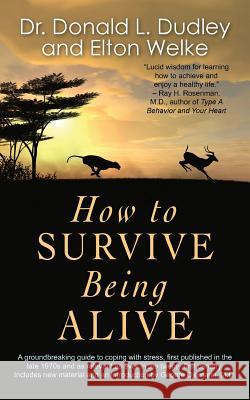How to Survive Being Alive » książka
How to Survive Being Alive
ISBN-13: 9781603811606 / Angielski / Miękka / 2014 / 212 str.
In 1977, the theory that stress, positive as well as negative, could lead to accidents or illnesses was far outside the mainstream. How could a pleasurable and exciting event such as a promotion, a marriage, a financial windfall, a vacation, or even Christmas be a bad thing? In their book, How to Survive Being Alive, authors Elton Welke and the late Dr. Donald L. Dudley put in plain language what many doctors had always suspected-that the body responds to life's highs and lows by lowering its defenses. Dudley and Welke's introduction of life-change scales to laymen clearly identified the possible consequences of experiencing too many changes all at once or making drastic revisions in life-style. They included the Social Readjustment Rating Scale, first created by psycho-physiologists Thomas H. Holmes and Richard H. Rahe, which provided a practical means of measuring the stress-related consequences that certain events and milestones can precipitate. How to Survive Being Alive dramatically and permanently changed the dialog between doctor and patient. As a direct result of its publication in 1977, many more doctors began to consider the physical and mental states of their patients, rather than simply treating symptoms. This classic guide to identifying and learning to cope with stress as well as improving interpersonal relations with others is also surprisingly relevant in our even more hectic twenty-first century world.
In 1977, the theory that stress, positive as well as negative, could lead to accidents or illnesses was far outside the mainstream. How could a pleasurable and exciting event such as a promotion, a marriage, a financial windfall, a vacation, or even Christmas be a bad thing? In their book, How to Survive Being Alive, authors Elton Welke and the late Dr. Donald L. Dudley put in plain language what many doctors had always suspected-that the body responds to lifes highs and lows by lowering its defenses. Dudley and Welkes introduction of life-change scales to laymen clearly identified the possible consequences of experiencing too many changes all at once or making drastic revisions in life-style. They included the Social Readjustment Rating Scale, first created by psycho-physiologists Thomas H. Holmes and Richard H. Rahe, which provided a practical means of measuring the stress-related consequences that certain events and milestones can precipitate. How to Survive Being Alive dramatically and permanently changed the dialog between doctor and patient. As a direct result of its publication in 1977, many more doctors began to consider the physical and mental states of their patients, rather than simply treating symptoms. This classic guide to identifying and learning to cope with stress as well as improving interpersonal relations with others is also surprisingly relevant in our even more hectic twenty-first century world.











